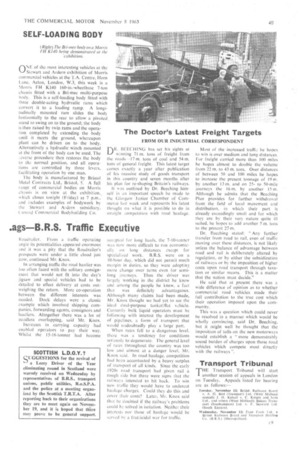SELF-LOADING BODY
Page 53

If you've noticed an error in this article please click here to report it so we can fix it.
QNE of the most interesting vehicles at the Stewart and Ardern exhibition of Morris commercial vehicles at the T.A. Centre, Horn
Lane. Acton, London, W.3, this week is a Morris FH K140 160-in.-wheelbase 7-ton chassis fitted with a Bri-mec multi-purpose body. This is a self-loading body fitted with three double-acting hydraulic rams which convert it to a loading ramp. A longitudinally mounted ram slides the body horizontally to the rear to allow a pivoted stand to swing on to the ground; the body is then raised by twin rams and the operation completed by extending the body until it meets the ground, whereupon plant can be driven on to the body. Alternatively a hydraulic winch mounted at the front of the body can be used. The ; everse procedure then restores the body to the normal position, and all operations are controlled by three levers, facilitating operation by one man.
The body is manufactured by Bristol Metal Contracts Ltd., Bristol, 5. A full range of commercial bodies on Morris chassis is on view at the exhibition,. which closes tonight (Friday) at 7 p.m., arid includes examples of bodywork by the Stewart and Ardern subsidiary.
unard Commercial Bodybuilding Co.
DR. BEECH1NG has set his sights at winning 71 m. tons of freight from the roads-17 tn. tons of coal and 54 m. tons of general freight. This latest target comes exactly a year after publication of his massive study of goods transport in this country and seven months after his plan for re-shaping Britain's railways.
It was outlined by Dr. Beeching himself in an important speech he made to the Glasgow Junior Chamber of Commerce last week and represents his latest thought on what it is possible to do in straight competition with road haulage.
Most of the increased traffic he hopes to win is over medium and long distances. For freight carried more than 100 miles he hopes almost to double the volume from 22 m, to 43 m. tons. Over distances of between 50 and 100 miles he hopes to increase the present tonnage of 19 m. by another 13 m. and on 25to 50-mile journeys the 16 m. by another 15 m. Although he admits that the Beeching Plan provides for further withdrawal from the held of local movement and distribution, in which their part is already exceedingly small and for which they are by their very nature quite ill suited, he hopes to add another 5 m. tons to the present 27 m.
Dr. [leeching stated: "Any further transfer from road to rail, even of traffic moving over these distances, is not likely unless the balance of advantage between road and rail is deliberately altered by regulation, or by either the subsidization of railways or by the imposition of higher costs upon road transport -through taxation or similar means, This is a matter that the nation must decide."
He said that at present there was a wide difference of opinion as to whether commercial road vehicles made their full contribution to the true cost which their operation imposed upon the community.
This was a question which could never be resolved in a manner which would be wholly convincing, said Dr. Beeching, but it might well he thought that the imposition of tolls on the new motorways would establish a "more demonstrably sound burden of charges upon those road vehicles which compete most directly with the railways ".














































































































































































































































